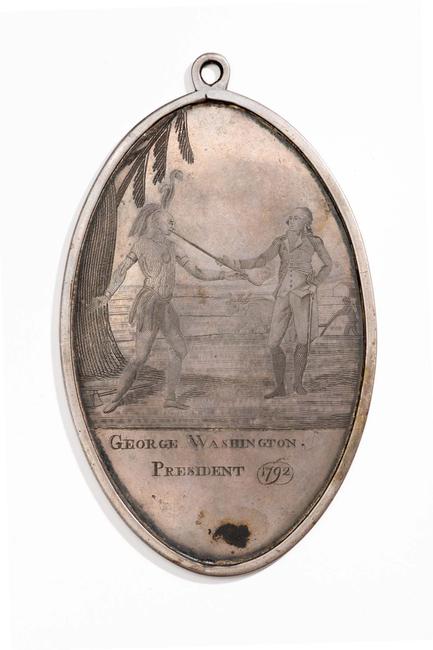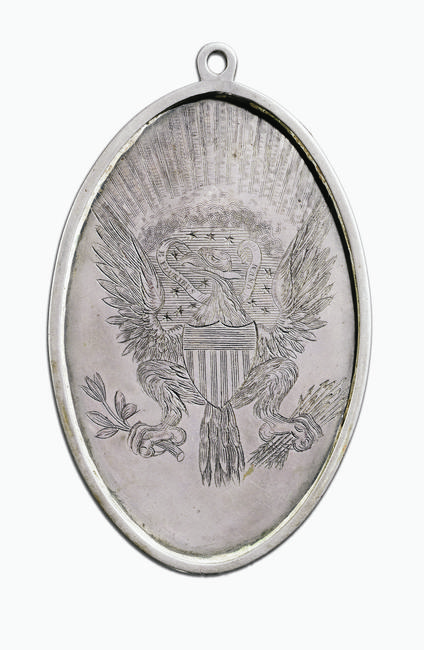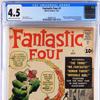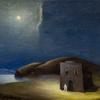Rare George Washington Indian Peace Medal Acquired by the Colonial Williamsburg Foundation
- WILLIAMSBURG, Virginia
- /
- July 12, 2021

When George Washington was inaugurated as the first President of the United Sates 232 years ago in April 1789, the nation’s leaders were well aware that “peace medals” given as diplomatic gifts to American Indian leaders had vital impact. Considered to be of paramount historical significance and the highest rarity, most of the authentic engraved Indian peace medals of the Washington presidency are found in institutional collections; of the medals made in 1792, the first year they were issued and awarded primarily to Southern Chiefs, perhaps a dozen are known. Colonial Williamsburg has recently acquired one the finest of only approximately six small-sized medals currently recorded. Crafted in Philadelphia, Pennsylvania, of silver by an unidentified silversmith, this Washington Indian peace medal is 5-1/4” tall by 3-3/16” wide and weighs 76.15 grams. The medal is now on view in the Backcountry section of A Rich and Varied Culture: The Material World of the American South, a long-term exhibition at the DeWitt Wallace Decorative Arts Museum, one of the newly expanded Art Museums of Colonial Williamsburg.
“Acquisition of this well-preserved medal provides Colonial Williamsburg an outstanding opportunity to interpret the story of relationships between the United States government and the American Indian nations residing in the southern states,” said Ronald L. Hurst, the Foundation’s Carlisle H. Humelsine Chief Curator and vice president for museums, preservation, and historic resources. “It also advances our long-standing determination to ensure that the collections represent the diversity of the early American population.”
The custom of giving peace medals has a long history in America. By the French and Indian War, Anglo-Americans began producing impressive medals in hopes of competing against varied European interests for the allegiance of diverse Native American groups. These include medals commissioned by the Quakers struck in Philadelphia for the 1757 Treaty of Easton and Virginia’s “Happy While United” medals of 1780.
The newly formed War Department staff, responsible for overseeing Indian affairs, found it challenging to procure these indispensable silver medals. Without the necessary minting machinery, each had to be handmade and painstakingly engraved by expert craftsmen in order to convey the importance embodied in these large, high-quality medals. The work was time consuming and expensive, but the United States government considered it worth the price as they were enthusiastically appreciated by the recipients.

In 1792, a spectacular design was created that began the custom of featuring a prominent image of the sitting president on the front of the medal. This tradition continued for nearly a century until the Indian peace medal program ended in 1891. The new design, which was very large and oval, presented a view of George Washington helping to support a pipe being smoked by a traditionally dressed American Indian warrior. On equal footings, the president appears in his military uniform while his ally wears armbands, a feathered headdress and a large oval medal around his neck. Behind the warrior rests his tomahawk placed on the ground. This peace ceremony is depicted at the edge of a wood with the warrior below the branches of a tree and Washington before an agricultural scene. Below is the legend GEORGE WASHINGTON, PRESIDENT 1792. The reverse side features an engraving of the Great Seal of the United States.
“I can’t put into words how thrilled I am to be adding this incredibly rare medal to Colonial Williamsburg’s holdings,” said Erik Goldstein, Colonial Williamsburg’s senior curator of mechanical arts & numismatics. “Though it fills a tremendous void in the collection, I never thought it would be possible, and the fact that it’s of the finest style is just icing on the cake.”
These resplendent objects were seen as supreme emblems of importance and position by both parties. Official gifts of the United States, they were made in three sizes and given according to the rank of the accepting Chief. Bestowed with great pomp and ceremony, each medal was accompanied by a certificate that spelled out the credentials of the holder and the requirements of deference and respect owed to him by others. At the time, these esteemed American Indian leaders were often referred to as Grand Medal Chiefs.
Secretary of War Henry Knox directed that a Cherokee delegation, visiting Philadelphia in early 1792, “…be liberally supplied with presents….and of distinctive silver Medals,” in addition to twenty more sets of medals for “the principal Chiefs of the Chickasaws and Choctaws,” as Knox referred to them. In addition to those sent to Southern tribes, at least two went to Seneca Chiefs from New York, like Red Jacket, who posed wearing his 1792 medal in the 1820s.
Production of the large format oval medals ended in 1795, likely because of the expense and difficulty of having them hand-made, perhaps compounded by an increasing need for them. Today, the engraved Indian peace medals of George Washington’s presidency remain at the pinnacle of early American numismatic and historical treasures.
This acquisition was made possible through Colonial Williamsburg’s Lasser Numismatics Fund.
Additional information about the Art Museums and Colonial Williamsburg as well as tickets are available online at colonialwilliamsburg.org, by calling (855) 296-6627 and by following Colonial Williamsburg on Facebook and @colonialwmsburg on Twitter and Instagram.
About the Art Museums of Colonial Williamsburg
The Art Museums of Colonial Williamsburg include the Abby Aldrich Rockefeller Folk Art Museum and the DeWitt Wallace Decorative Arts Museum, both of which are housed in their newly expanded building that offers an additional 65,000-square-feet of space, 25-percent more gallery space and numerous enhancements to the visitor experience. The Abby Aldrich Rockefeller Folk Art Museum is home to the nation’s premier collection of American folk art, with more than 7,000 folk art objects made up to the present day. The DeWitt Wallace Decorative Arts Museum exhibits the best in British and American fine and decorative arts from 1670–1840. The Art Museums of Colonial Williamsburg are located at 301 South Nassau Street in Williamsburg, Va. Open daily from 9:00 A.M. to 6:00 P.M.
About The Colonial Williamsburg Foundation
Colonial Williamsburg operates the world’s largest living history museum, preserving Virginia’s 18th-century capital as a fully functioning city. Fun, engaging experiences transport guests back in time and highlight the relevance of America’s founding era to contemporary life. The Colonial Williamsburg experience includes more than 600 restored or reconstructed buildings, historic trade shops, renowned museums of decorative arts and folk art, extensive educational outreach programs for students and teachers, lodging, culinary options from historic taverns to casual or elegant dining, the Golden Horseshoe Golf Club featuring 45 holes designed by Robert Trent Jones Sr. and his son Rees Jones, a full-service spa and fitness center managed by Trilogy Spa, pools, retail stores and gardens. Philanthropic support and revenue from admissions, products and hospitality operations sustain Colonial Williamsburg’s educational programs and preservation initiatives. The Colonial Williamsburg Foundation is a 501 (c)(3) nonprofit organization; philanthropic support and revenue from admissions, products and operations sustain its educational programs and preservation initiatives.
# # #
Contact:
Robyn LiverantRobyn Liverant Public Relations
robyn@robynliverant.com
















